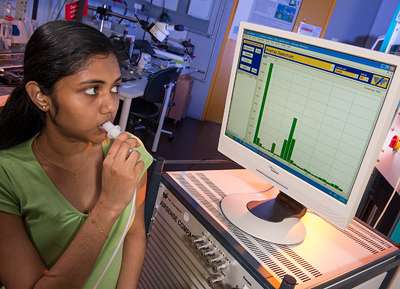Breathalyzer for diagnosis of lung diseases, potential for earlier detection

Siemens is researching a method that may make it possible to diagnose tuberculosis or lung cancer at an early stage using breath samples. The process involves an analysis of the molecular structure of the subject's breath. If the person concerned is ill, there is a shift in the relative quantities of molecules contained in his or her breath. As reported in the current issue of Pictures of the Future magazine, preliminary tests using breath samples from cancer and tuberculosis patients have been very promising. Now the process has to be verified using a larger and more diverse group of people.
According to the World Health Organization, 8.7 million people contracted tuberculosis worldwide in 2011 alone, and the disease killed 1.4 million patients that year. If this disease - which often seems to just be a bad cold when it starts - isn't diagnosed early enough, other people are infected. One effective solution involves a method that could help doctors recognize tuberculosis easily and early on. A method for reliably identifying lung cancer at an early stage has also been lacking until now. That's why the average life expectancy for a patient diagnosed with lung cancer is currently only around two years.
Scientists working for the Siemens global research department Corporate Technology are making use of the old insight that particular illnesses can be recognized by changes in the odors contained in a person's breath. The cocktail of highly complex molecules contained in a person's breath changes in specific ways when he or she is ill. Researchers use a quadrupole mass spectrometer to identify individual molecules and determine their concentration in the patient's breath. Here, the substances in the breath sample are electrically charged and accelerated through an electrical field which affects their trajectory. Particles of different weights are deflected to different degrees and thus land at different places on the detectors. In this way a kind of fingerprint is created from which conclusions about diseases can be drawn.
Now that trials with tuberculosis and lung cancer patients have been successful, testing has to be carried out in order to determine what influences age, sex and diet have on measurements. Tests of smokers are also pending. If the initial positive results are confirmed, the technology could be further developed for practical applications. To make it suitable for use in a doctor's office, the spectrometer will have to be made small enough to fit inside a suitcase. Additionally, the software will need to be optimized so that it is simple to use.

















